God has a sense of humour: drive two hours north from Toronto to escape the summer heat, and even in an old church overlooking Georgian Bay, it’s hotter than it was back home. The heat is thick and it slows you down and reminds you of stories your father told about going to a “jungle church” in Sri Lanka every August, as a child, in caravans that set up tents and huts around the building for days and nights of prayer and song, feast and play, all in muggy, snake-infested lands. He loved those pilgrimages, but fear of the slouching beast of Ontario summer traffic trumped hope of renewing an old devotion in Upper Canada.
Listen to an audio version of this story
For more audio from The Walrus, subscribe to AMI-audio podcasts on iTunes.
When I was growing up—“back home” for me is 1980s Oshawa—we never made the trek to the Canadian Martyrs’ Shrine, which is Canada’s nearest approximation of Our Lady of Madhu, in Sri Lanka. Founded in 1926 near Midland, Ontario, the shrine honours the seventeenth-century martyrdoms of Saint Jean de Brébeuf and his companions. It has since become the proxy destination for other Catholic immigrant groups seeking to continue pilgrimages and devotions associated with their home countries and religious communities. Last July, under the cover of family life and the writing life, I drove there to pray with some Sri Lankans.
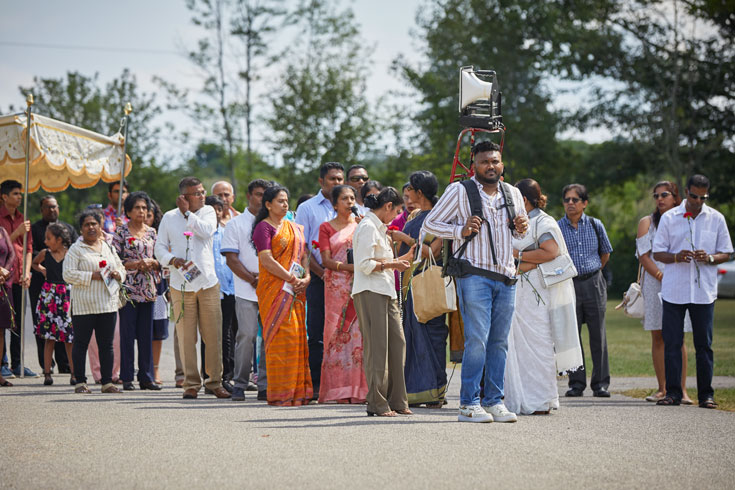
Because of childhood stories and because the timing of our visit fell mere months after the 2019 Easter Sunday suicide bombings—a coordinated series of attacks in Sri Lanka that portended a new arrangement of sectarian conflict and division in a country still dealing with the traumatic legacies of a civil war that ended brutally and decisively in 2009—I was prepared for a dramatic demonstration of Sri Lankan communion. You’d certainly expect to see far more than a thousand people coming together if you combined the Sri Lanka–related Catholic communities from around Toronto into a single day’s trip to cottage country. I had already witnessed the sort of spectacle that can be induced by this shrine, which draws visitors from all over Canada in spite of its size and relative geographical obscurity. I inadvertently attended the Tamil Catholic pilgrimage two years ago, when I visited the Martyrs’ Shrine one July morning with my daughters. We were staying at a cottage nearby and had intended to go to a quiet little summertime Mass before taking in a matinee show of Ant-Man and the Wasp. Instead, we were stuck in purgatorial traffic along Highway 12 before joining thousands of GTA Tamil pilgrims, who packed the church, which holds 500 and, on that day, hosted more than 8,000—and whose vehicles spilled over parking lot lines to pack unpaved roads and take up space all over the rolling green shrine lands.
I don’t know how the Jesuits decide which of some thirty-two different ethnic Catholic groups gets to enact its particular pilgrimage to the shrine on what date in a summer-long industrial-scale version of Eat Pray Love. It must involve a combination of practical considerations, respect for long-standing, internally coherent immigrant-community religious practices, and perhaps a more quiet desire to avoid the possibility of old grievances coming to life in a new place. Last year, the Sunday closest to the traditional date of the Madhu feast day went to the Italians. The Polish and Syro-Malabar got the dates around the Assumption, another very important Catholic feast day in Sri Lanka. Sri Lankan Catholics’ faith dates only to the early sixteenth century, making them youngsters compared to the Italians (Saint Paul was preaching in Rome mere decades after Christ’s crucifixion), Syro-Malabars (52 AD), Poles (the tenth century), and in fact closer in age to First Nations Catholics, whose own pilgrimage day at the shrine was June 22. In Sri Lanka, the major pilgrimages to Our Lady of Madhu church happen either on July 2, the feast day of the most prominent devotion in Sri Lankan Catholicism, or around August 15, to commemorate the more widely celebrated Feast of the Assumption—which informed my decision to travel to the shrine when I did, in the deep, dead heat of summer.
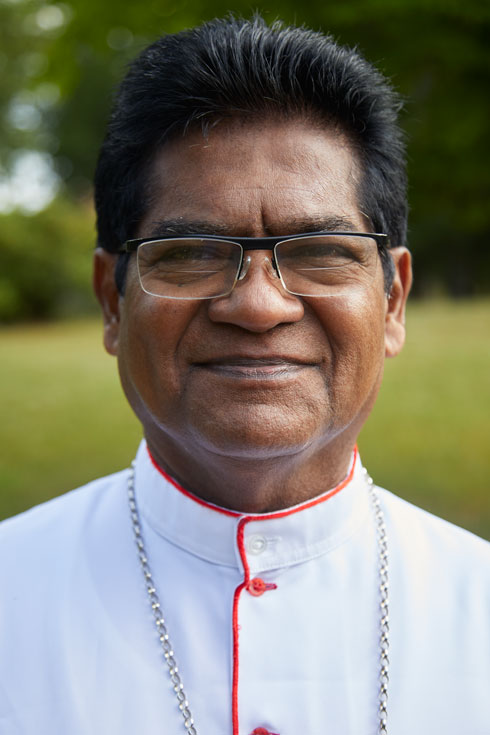
In any event, on the day of our visit, the turnout was at best only in the high hundreds. I noted that the program I picked up from one of the display tables near the outdoor altar declared on its front cover, “Let’s Pray for Unity in Sri Lanka.” It was the liturgical equivalent of a talking point during the Mass itself, by a bishop who had come from Colombo to preside over the pilgrimage. With limited success, forty-five minutes after Mass was supposed to have started, organizers asked the loitering, chatting, phone-tapping pilgrims to congregate for a rosary procession that would mark the formal start of the event. The walk started a long way from the altar. At the back of the procession, the presiding bishop carried a replica of Our Lady of Madhu—a small statue, whose presence in Sri Lanka dates back to at least 1543, of the crowned Virgin holding a child Christ. Wearing a shock-white cassock and a rich amaranth sash, the bishop walked under a gold-fringed beige canopy held up by guys in jeans and sneakers. Ahead of them was a monstrously amplified group of mostly older women, some children, and a few glum-looking teens, many holding droopy roses while reciting the rosary in Sinhala, Tamil, and English. They were led down the lane by altar servers slow-cooking in their heavy robes. At the very front: a smiling, chatty old white guy decked out in mildly militaristic Knights of Columbus finery.
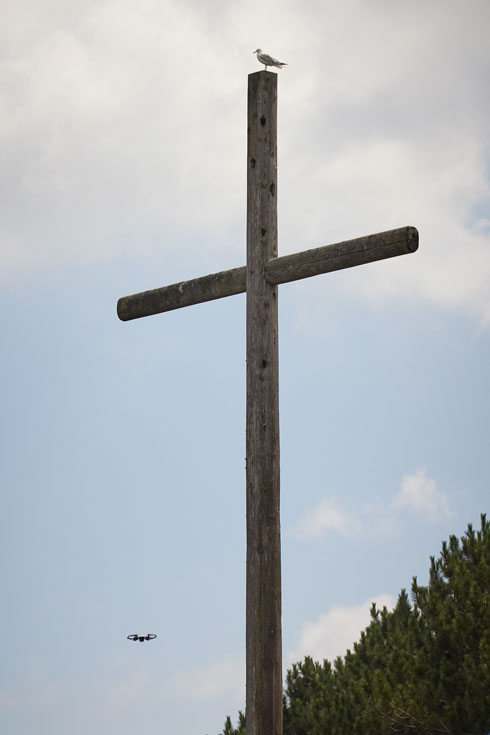
The procession was wonderfully broken up, near the altar, by a procession of done-up, dancing little girls followed by heat-sick flower girls dropping rose petals—they were dressed, respectively, in sequined and frilly white outfits that seemed Hindu and Buddhist. There’s probably some Catholic orthodoxy watchdog that’s already sent a letter to the local bishop about this, but those girls, dressed and dancing as they were, fit in perfectly well with the overall proceedings, or at least as well as the tray of Costco dessert bars melting on a display table, which served as the traditional offering of sweets, alongside a dignified cheeseball arrangement of silver crucifixes, flanking Canadian and Sri Lankan flags, pseudotropical flowers, and a wood carving of Sri Lanka itself, that last item probably straight out of a Colombo airport gift shop.
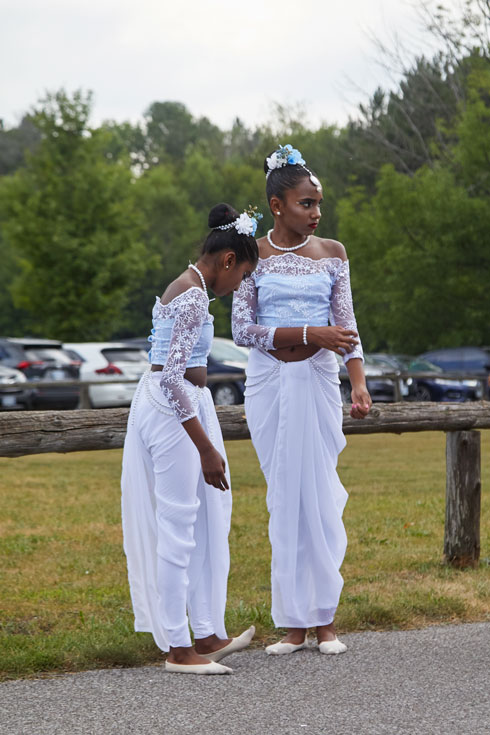
The stately older ladies dressed in diaphanous dark and bright saris that swished across the scrubby greenery of the nearby Canadian Shield likewise fit in fine, as did the tall gleaming rooster-topped brass oil lamp flanking the altar’s right, which, in keeping with Sri Lankan tradition, was lit by business-suited dignitaries using an unreliable barbecue lighter. The many minivans, rusted-out sedans, and vanity-plated luxury cars parked under every available stand of shade trees also made sense. The cars had rosary beads hanging from rear-view mirrors and trunks packed with oil-stained silver cooking pots and plastic bags of short eats and string hoppers from takeout shops in Scarborough and Brampton.
In both contemporary Canadian and global Catholic terms, all of this sprawling brown life going on under endless tall green pines made for only superficially unexpected juxtapositions of difference, whether religious, geographic, economic, or cultural. In reality, these densely packed, fused-together moments and experiences of here and there, then and now, are the baseline realities of life in modern Canada and of universal life as a Catholic. The latter became even more apparent when the bishop delivered his homily. Squinting against the harsh midday sun and looking miraculously sweat-free in his heavy green liturgical vestments, the bishop, in a single seamless sentence, proposed a hard, true kind of unity, invoking the seventeenth-century martyrs of both Ceylon and Ontario, the first- and third-century martyrs of Nero’s and Diocletian’s Rome, and the twenty-first-century martyrs of Sri Lanka. His point: the church was built—is built, continues to be built—on the blood of martyrs.
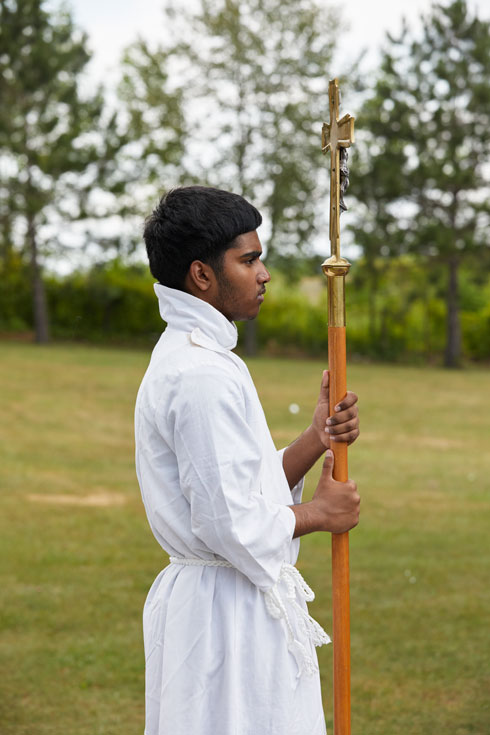
But none of the pilgrims seemed particularly affected by his remarks, never mind concerned about the nontraditional timing of the event. Instead, they just went about their holy holiday business, keeping babies quiet and children cool under the high sun; taking pictures of the raccoon-size drone hovering overhead to film the festivities; negotiating trash barrels and cooler bags on the way to communion; lining up after Mass to venerate, with hands and kisses and iPhones, the Upper Canada edition of the Our Lady of Madhu statue; walking from booth to booth accepting gifts of cold bottled water and lukewarm spicy pastries from proud representatives of the Sri Lankan Canadian business community; and, eventually, making their way over to the cool dark shrine, both for a break from the heat and to pray.
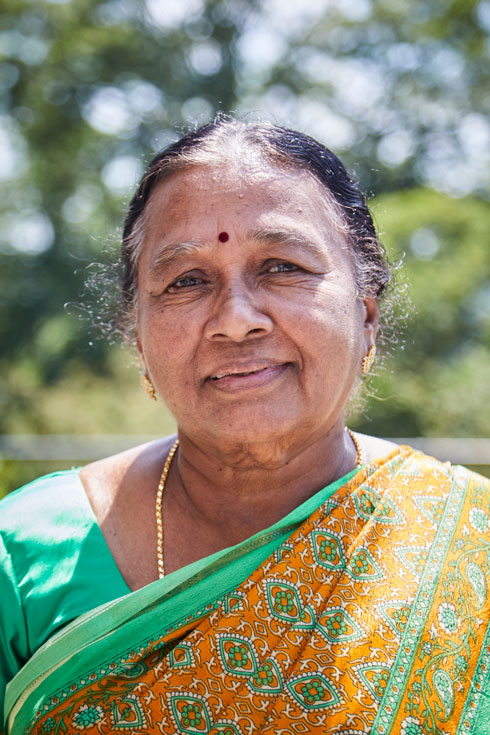
I kept wanting there to be more. I wanted the Sri Lankan Catholic globalized pilgrimage to rural Ontario to be fuller in every possible way—to be a wild, grand, polychromatic statement of an ongoing, intercontinental, intercultural, transhistorical, even cosmic drama of unified human experience in a fraught, fragmented, and mobile age, no less a drama that I had connections to through my own family and faith and life in Canada. It was what it was, just not what I imagined it would be; if anything, I was the source of the day feeling off-kilter. Everything and everyone fit in fine with everything and everyone else, just as they had last year, and last century, and will again this summer, and next summer, and next century.
One group kept catching my eye. Four young men were hanging around before Mass, lingering at the margins during Mass, then venerating statues in the Martyrs’ Shrine after Mass. They were in their twenties, goateed, gold-chained, constantly checking their phones and swaggering around in new running shoes and untucked sports jerseys. So far as I could tell, they were here together and on their own. They hadn’t come to the shrine because their mothers or grandmothers had guilted them into the car that morning or because their entrepreneurial aunties needed help setting up a food tent or, had they been a little older, because their wives were insisting this was something good to do together as a family. They had come of their own accord.
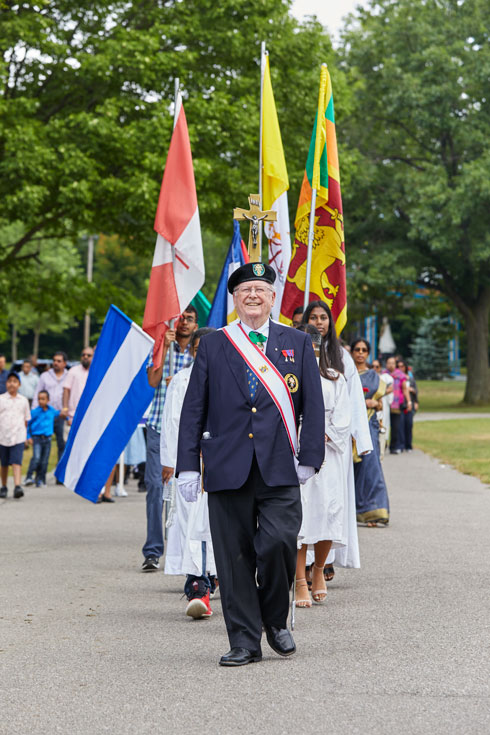
These four young men were the last people you’d expect to see at a religious pilgrimage north of Toronto. I think they knew it too. After declining to be photographed, they bro-swaggered their way out of the church. I watched them disappear around a cornerstone, and then the story my father told me of his last pilgrimage to Our Lady of Madhu in Sri Lanka gyred into focus. It took place fifty years ago, in 1970. This was his triumphant first return trip to Ceylon after immigrating to Canada in 1967. Upon arriving, at the start of his summer break as a high-school chemistry teacher, he learned that his mother had already arranged for him to join the pilgrimage to Madhu. “So you went?” I asked, imagining how out-of-place he would have seemed, a twenty-eight-year-old bachelor in Age of Aquarius bell-bottoms praying among the sarong- and sari- and slack-wearing pilgrims of Ceylon. “I did.” Another memory swerves in front. “My cousin also went . . . with his girlfriend . . . in a sports car . . . a Karmann Ghia.”
Correction August 27, 2020: An earlier version of this story stated that the Canadian Martyrs’ Shrine was on the Canadian Shield. In fact, the shrine is just outside the Canadian Shield region. The Walrus regrets the error.




